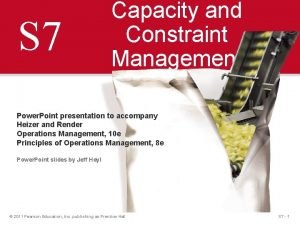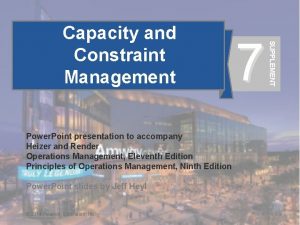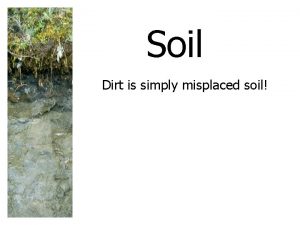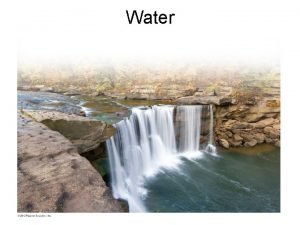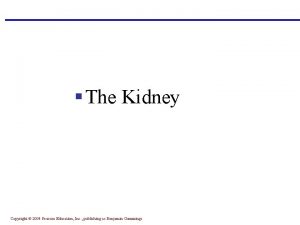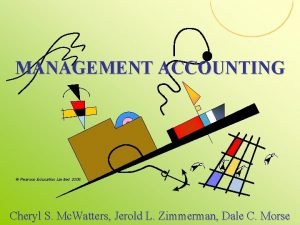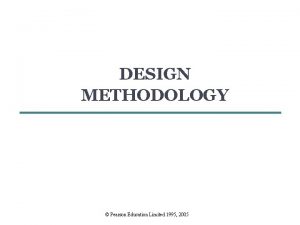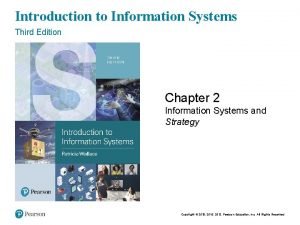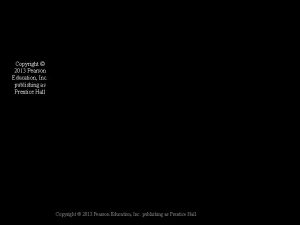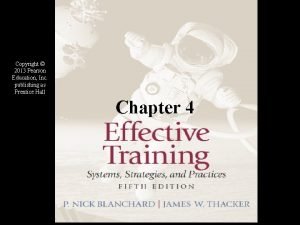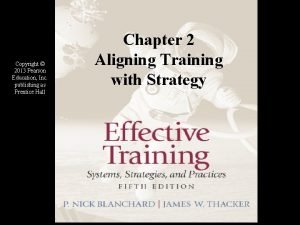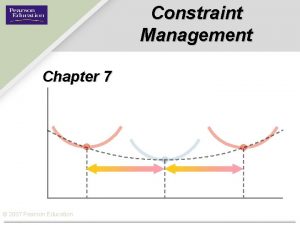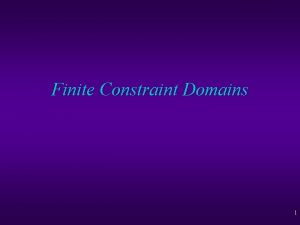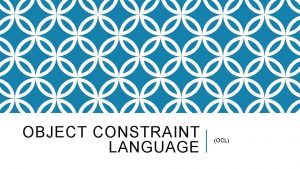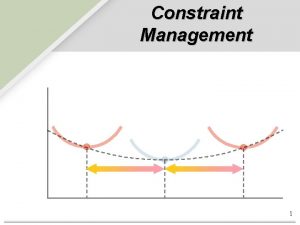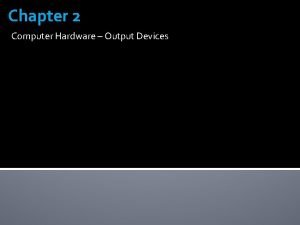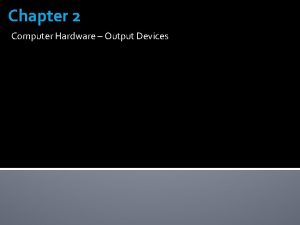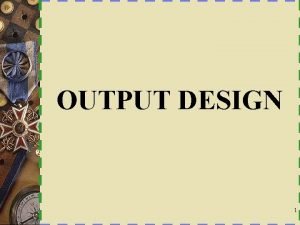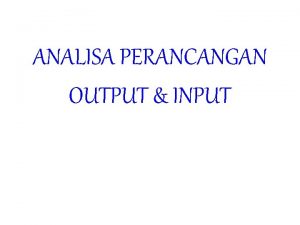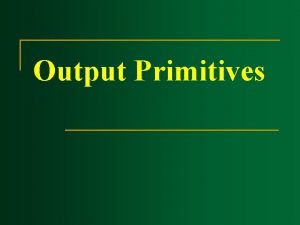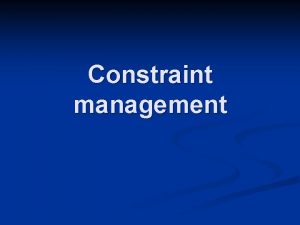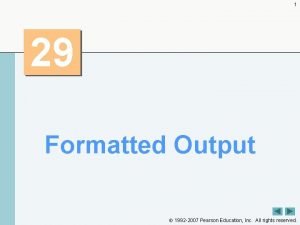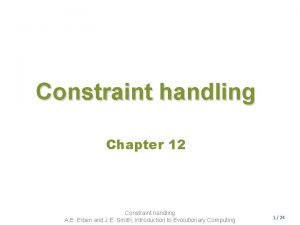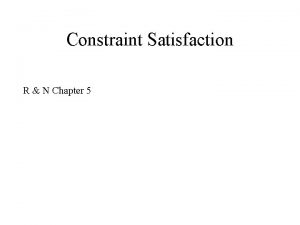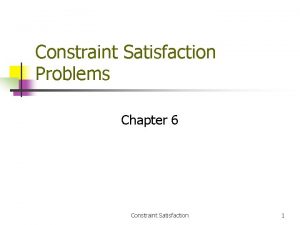Constraint Management Chapter 7 2007 Pearson Education Output































- Slides: 31

Constraint Management Chapter 7 © 2007 Pearson Education

Output and Capacity Ø What is a Constraint? Ø Any factor that limits system performance and restricts its output. Ø Capacity is the maximum rate of output of a process or system. Ø A Bottleneck Ø An output constraint that limits a company’s ability to meet market demand. Ø Also called Capacity Constraint Resource or CCR © 2007 Pearson Education

Theory of Constraints (TOC) Ø A systematic approach that focuses on actively managing constraints that are impeding progress. Constraint Management Short-Term Capacity Planning Long-term Capacity Planning Ø Theory of Constraints Ø Identification and management of bottlenecks Ø Product Mix Decisions using bottlenecks Ø Economies and Diseconomies of Scale Ø Capacity Timing and Sizing Strategies Ø Systematic Approach to Capacity Decisions © 2007 Pearson Education

Measures of Capacity Ø Output Measures: for example, the number of cars produced per day Ø Best utilized when applied to firms with small number of standardized products and services. Ø Input Measures: such as number of workstations or number of workers Ø Suitable for low volume, flexible process Ø Should transfer the demand measures with the same unit Ø Utilization: the degree to which equipment, space, or the workforce is currently being used. © 2007 Pearson Education

Performance Measures in TOC ØInventory (I) ØThroughput (T) ØOperating Expense (OE) ØUtilization (U) © 2007 Pearson Education

7 Key Principles of TOC 1. The focus is on balancing flow, not on balancing capacity. 2. Maximizing output and efficiency of every resource will not maximize throughput of the entire system. 3. An hour lost at a bottleneck or constrained resource is an hour lost for the whole system. An hour saved at a non-constrained resource does not necessarily make the whole system more productive. © 2007 Pearson Education

7 Key Principles of TOC 4. Inventory is needed only in front of the bottlenecks to prevent them from sitting idle, and in front of assembly and shipping points to protect customer schedules. Building inventories elsewhere should be avoided. 5. Work should be released into the system only as frequently as the bottlenecks need it. Bottleneck flows should be equal to the market demand. Pacing everything to the slowest resource minimizes inventory and operating expenses. © 2007 Pearson Education

7 Key Principles of TOC 6. Activation of non-bottleneck resources cannot increase throughput, nor promote better performance on financial measures. 7. Every capital investment must be viewed from the perspective of its global impact on overall throughput (T), inventory (I), and operating expense (OE). © 2007 Pearson Education

Application of TOC 1. Identify The System Bottleneck(s). 2. Exploit The Bottleneck(s): create schedules that maximize throughput of the bottleneck(s). 3. Subordinate All Other Decisions to Step 2: nonbottleneck resources should be scheduled to support the schedule of the bottleneck and not produce more than it can handle 4. Elevate The Bottleneck(s): increase its capacity 5. Do Not allow the system constraint to shift. If so, the whole process must be repeated. © 2007 Pearson Education

Identification and Management of Bottlenecks Ø A Bottleneck is the process or step which has the lowest capacity and longest throughput. Ø Throughput Time is the total time from the start to the finish of a process. Ø Bottlenecks can be internal or external to a firm. © 2007 Pearson Education

Setup Time Ø If multiple services or products are involved, extra time usually is needed to change over from one service or product to the next. Ø This increases the workload and could be a bottleneck. Ø Setup Time is the time required to change a process or an operation from making one service or product to making another. © 2007 Pearson Education

Where is the Bottleneck? Example 7. 1 Customer No 3. Check for credit rating (15 minutes) 1. Check loan documents and put them in order (10 minutes) 2. Categorize loans (20 minutes) Bottleneck 5. Is loan approved? (5 min) Yes 6. Complete paperwork for new loan (10 minutes) 4. Enter loan application data into the system (12 minutes) It takes 10 + 20 + max (15, 12) + 5 + 10 = 60 minutes to complete a loan application. Unless more resources are added at step B, the bank will be able to complete only 3 loan accounts per hour, or 15 new load accounts in a five-hour day. © 2007 Pearson Education

Long-Term Capacity Planning Constraint Management Short-Term Capacity Planning Long-term Capacity Planning Ø Theory of Constraints Ø Identification and management of bottlenecks Ø Product Mix Decisions using bottlenecks Ø Economies and Diseconomies of Scale Ø Capacity Timing and Sizing Strategies Ø Systematic Approach to Capacity Decisions © 2007 Pearson Education

Long-Term Capacity Planning Ø Deals with investment in new facilities and equipment. Ø Plans cover a minimum of two years into the future. Ø Economies of scale: a concept that states that the average unit cost of a service or good can be reduced by increasing its output rate. © 2007 Pearson Education

Economies of scale Ø Economies of scale are sought in order to reduce costs through ØLower fixed costs per unit ØQuantity discounts in purchasing materials ØReduced construction costs ØProcess advantages © 2007 Pearson Education

Economies of Scale Average unit cost (dollars per patient) Ø Economies of scale occur when the average unit cost of a service or good can be reduced by increasing its output rate. Ø Diseconomies of scale occur when the average cost per unit increases as the facility’s size increases 250 -bed hospital 500 -bed hospital Economies of scale © 2007 Pearson Education 750 -bed hospital Diseconomies of scale Output rate (patients per week)

Capacity Timing and Sizing Strategies 1. Sizing Capacity Cushions 2. Timing and Sizing Expansions 3. Linking Process Capacity and other operating decisions. © 2007 Pearson Education

Capacity Cushions A capacity cushion is the amount reserve capacity a firm has available. Capacity Cushion = 100% − Utilization Rate (%) How much capacity cushion depends on • The uncertainty and/or variability of demand • The cost of lost business • The cost of idle capacity © 2007 Pearson Education

Capacity Expansionist Strategy Staying ahead of demand Capacity Planned unused capacity Capacity increment Time between increments Time © 2007 Pearson Education Forecast of capacity required

Capacity Expansion Wait-and-See Strategy Chasing demand Capacity Planned use of short-term options Capacity Increment Time between increments Time © 2007 Pearson Education Forecast of capacity required

Expansionist strategy Ø Minimizes the chance of sales lost to insufficient capacity. Ø Can result in economies of scale and a faster rate in learning Ø Might increase the firm’s market share © 2007 Pearson Education

Wait-and-see strategy Ø Lags behind demand Ø To meet any shortfalls, it relies on shortterm options: ØOvertime ØTemporary workers ØSubcontractors ØStockouts Øpostponement of preventive maintenance on equipment © 2007 Pearson Education

Wait-and-see strategy Ø Uses smaller increments, such as by renovating existing facilities rather than building new one Ø Reduces the risks of overexpansion Ø Unable to respond if demand is unexpectedly high. Ø An intermediate strategy could be to follow the leader © 2007 Pearson Education

A Systematic Approach To Long -Term Capacity Decisions 1. Estimate future capacity requirements. 2. Identify gaps by comparing requirements with available capacity. 3. Develop alternative plans for filling the gaps. 4. Evaluate each alternative and make a final choice. © 2007 Pearson Education

Step 1: Estimating Capacity Requirements Ø Capacity Requirement is determined over some future period based on demand desired capacity cushion. Ø Planning Horizon is a set of consecutive future time periods for planning purposes. © 2007 Pearson Education

1) Using Output Measures for Estimating Capacity Requirements Ø Output Measures are the simplest way to express capacity. Ø Products produced or customers served per unit of time Example: Current capacity is 50 per day and demand is expected to double in five years. Management uses a capacity cushion of 20%. Capacity (M) in 5 years should be: M = 100/(1 - 0. 2) = 125 customers © 2007 Pearson Education

2) Using Input Measures for Estimating Capacity Requirements Input Measures are typically based on resource availability. – Availability of workers, machines, workstations, seats, etc. Capacity Requirement = Processing and setup hours required for year’s demand, summed over all services and products Hours available from a single capacity unit per year, after deducting desired cushion [Dp+(D/Q)s]product 1+[Dp+(D/Q)s]product 2+ …+[Dp+(D/Q)s]product n M= D p N C N[1 – (C/100)] = = demand forecast for the year processing time total number of hours per year during which the process operates desired capacity cushion, expressed as a percentage © 2007 Pearson Education

Surefoot Sandal Company Application 7. 4 Ø Put together a capacity plan for a critical bottleneck operation at the Surefoot Sandal Company. Capacity is measured as number of machines. Three products (men’s, women’s, & children’s sandals) are manufactured. The time standards, lot sizes, and demand forecasts are given below. There are two 8 -hour shifts operating 5 days per week, 50 weeks per year. Experience shows that a capacity cushion of 5 percent is sufficient. a. How many machines are needed? b. If the operation currently has two machines, what is the capacity gap? © 2007 Pearson Education

Surefoot Sandal Company Application 7. 4 Solution © 2007 Pearson Education

Surefoot Sandal Company Application 7. 4 Solution © 2007 Pearson Education

Identifying Gaps and Developing Alternatives Ø A Capacity Gap is any difference, positive or negative, between forecast demand current capacity. Ø Alternatives can be anything from doing nothing (Base Case), and various timing and sizing options (including the expansionist and wait-and-see strategies) Ø Evaluation of each alternative is important. © 2007 Pearson Education
 2011 pearson education
2011 pearson education Pearson education inc publishing as pearson prentice hall
Pearson education inc publishing as pearson prentice hall Pearson education inc publishing as pearson prentice hall
Pearson education inc publishing as pearson prentice hall Pearson education inc. 2012
Pearson education inc. 2012 Pearson education inc publishing as pearson prentice hall
Pearson education inc publishing as pearson prentice hall Capacity and constraint management
Capacity and constraint management Capacity and constraint management
Capacity and constraint management Quadruple constraint project management
Quadruple constraint project management Pearson vue ceo
Pearson vue ceo Educational pearson pearson times
Educational pearson pearson times Mitochondria
Mitochondria Simply misplaced
Simply misplaced Pearson education
Pearson education Pearson education
Pearson education Pearson education limited 2008
Pearson education limited 2008 Nitrogen cycle pearson education
Nitrogen cycle pearson education Pearson education limited 2005
Pearson education limited 2005 2018 pearson education inc
2018 pearson education inc Pearson education
Pearson education 2017 pearson education inc
2017 pearson education inc 2017 pearson education inc
2017 pearson education inc 2017 pearson education inc
2017 pearson education inc 2017 pearson education inc
2017 pearson education inc 2017 pearson education inc
2017 pearson education inc 2017 pearson education inc
2017 pearson education inc Pearson education inc 4
Pearson education inc 4 Pearson education, inc.
Pearson education, inc. 2014 pearson education inc
2014 pearson education inc 2013 pearson education inc
2013 pearson education inc 2013 pearson education inc
2013 pearson education inc 2013 pearson education inc
2013 pearson education inc 2013 pearson education inc
2013 pearson education inc





